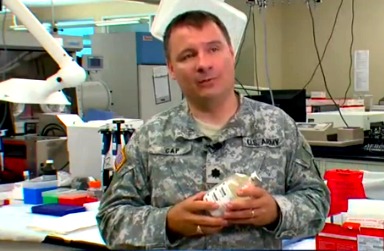
Col. Andrew Cap, the division chief of Acute Combat Casualty Research at the Army Institute of Surgical Research
During his fellowship at NIH, a group of French researchers arrived on campus for a symposium on their work creating freeze-dried plasma. Thanks to two college professor parents who both spoke French, Cap grew up speaking the language and ended up providing simultaneous translation during the question and answer session. This cemented a lasting connection with the French team, whose freeze-dried plasma was determined to be a much-needed addition to combat medicine. As the head of the blood research program at USAISR, Cap would help hammer out the investigational new drug protocol that allowed the plasma to be approved for use on American soldiers.
“Now that product has been out there with the Rangers and other special forces groups, and it’s saved some lives,” Cap declared.
At USAISR, Cap continued his work examining platelet function, this time with an eye toward how to improve combat care. Platelets were one of the weak links in providing transfusions on the battlefield. Stored at room temperature, they have a shelf life of about five days.
“It makes inventory management really hard,” Cap explained. “It’s a pain in the hospital, but it’s an even bigger pain downrange.”
Examining strategies for prolonging shelf life, Cap’s team determined that cold-stored platelets were still viable up to two weeks, effectively tripling how long the product could last.
As part of that research, they also examined the use of cold-stored whole blood. It had been thought that the red blood cells wouldn’t keep in the cold. Cap’s team determined otherwise.
“Our lab showed that the platelets in whole blood worked very well. That reinvigorated the whole blood field, and now 26 trauma centers around the world are using stored whole blood,” Cap explained. “In San Antonio, we have whole blood in our ground ambulance, air ambulance and trauma centers. We’re seeing the wisdom of this. The simplicity and the better function. But that wouldn’t have happened without investigating cold platelet storage.”
Currently, Cap is working on better understanding platelet and plasma, and how blood interacts with life support systems; the mechanism of shock in patients who have experienced extreme blood loss; and continuing work on improving whole blood storage–something that has not been examined since the 1970s.
In the meantime, he’s working with special forces groups to train them on how to bring the techniques he’s helping design in the lab and the hospital to the downrange combat setting. “USAISR is a nexus of all of these things where we can develop knowledge and material solutions that help shape care on the current and future battlefields,” Cap explained. “Then we can feed that back into the civilian community.”
